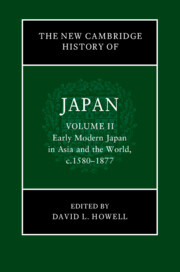Book contents
- The New Cambridge History of Japan
- The New Cambridge History of Japan
- The New Cambridge History of Japan
- Copyright page
- Contents
- Figures
- Maps
- Tables
- Contributors to Volume II
- Preface
- Frontispiece
- Introduction
- Part I The Character of the Early Modern State
- PART II Economy, Environment, and Technology
- Part III Social Practices and Cultures of Early Modern Japan
- 13 Religion in the Tokugawa Period
- 14 The Medical Revolution in Early Modern Japan
- 15 Flows of People and Things in Early Modern Japan
- 16 Labor and Migration in Tokugawa Japan
- 17 The Tokugawa Status Order
- 18 On the Peripheries of the Japanese Archipelago
- 19 The Early Modern City in Japan
- 20 Popular Movements in Early Modern Japan
- 21 Civilization and Enlightenment in Early Meiji Japan
- Index
- References
15 - Flows of People and Things in Early Modern Japan
Print Culture
from Part III - Social Practices and Cultures of Early Modern Japan
Published online by Cambridge University Press: 15 January 2024
- The New Cambridge History of Japan
- The New Cambridge History of Japan
- The New Cambridge History of Japan
- Copyright page
- Contents
- Figures
- Maps
- Tables
- Contributors to Volume II
- Preface
- Frontispiece
- Introduction
- Part I The Character of the Early Modern State
- PART II Economy, Environment, and Technology
- Part III Social Practices and Cultures of Early Modern Japan
- 13 Religion in the Tokugawa Period
- 14 The Medical Revolution in Early Modern Japan
- 15 Flows of People and Things in Early Modern Japan
- 16 Labor and Migration in Tokugawa Japan
- 17 The Tokugawa Status Order
- 18 On the Peripheries of the Japanese Archipelago
- 19 The Early Modern City in Japan
- 20 Popular Movements in Early Modern Japan
- 21 Civilization and Enlightenment in Early Meiji Japan
- Index
- References
Summary
Despite the restrictions that had been imposed on domestic travel since the early seventeenth century – which included checkpoints and the need for travel permits – in early modern Japan people traveled, merchandise moved, and ideas circulated. Commercial publishers played a key role in promoting the flows of people and things, not only with guidebooks and travel itineraries, as one would expect, but also in unusual places, such as board games and parodies of sumo rankings. Their output illuminates the democratization of knowledge and the creation of an interconnected archipelago in early modern Japan. More broadly, it reflects the global expansion of the information industry and the rise of tourism in the nineteenth century, linking Tokugawa Japan to dynamics at play the world over.
Keywords
- Type
- Chapter
- Information
- The New Cambridge History of Japan , pp. 507 - 536Publisher: Cambridge University PressPrint publication year: 2023

